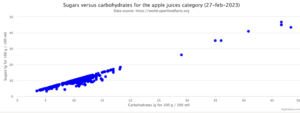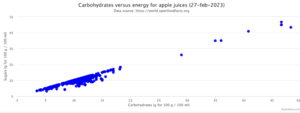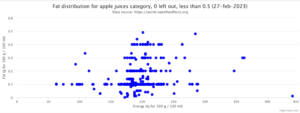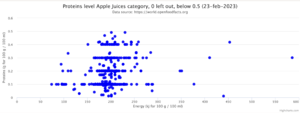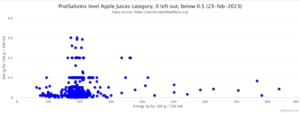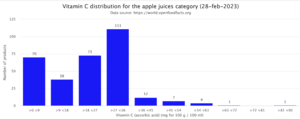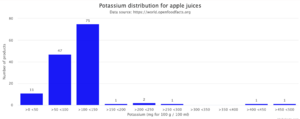Difference between revisions of "Apple juices category - en"
| Line 94: | Line 94: | ||
As can be seen in the graph, there are a lot of products with a salt level over 200 mg/100 ml. | As can be seen in the graph, there are a lot of products with a salt level over 200 mg/100 ml. | ||
=== Vitamin C === | === Vitamin C === | ||
| + | [[File:AppleJuicesVitaminC230228.png|frameless|center|Vitamin C distribution for the apple juices category (28-feb-2023)]] | ||
| + | Median 25mg/100ml; 80% percentile range: 0.5-33.9mg/100ml | ||
=== Potassium === | === Potassium === | ||
Revision as of 15:44, 28 February 2023
This page describes an in-depth look at the apple juices category on OFF. The purpose was to increase the quality of this category in terms of data and contained products.
What is apple juice?
This category is part of more generic categories as fruit juices and is defined as a beverage. There are no formal definitions for these categories yet, so we have to come up with some guidelines:
- drinkable, probably without any additional preparation
- fruit based, so not the fruit itself
- apple based, and probably lots of apple
It is necessary to loop better at the products that are now in the category to get an idea what people did put in. And then we might come up with a better definition. We also like to know what is not included in this category.
Current situation
At the moment of writing (27 feb 2023) there are 3132 products in the category, of which 2800 have nutrition facts. When scrolling through the products most are called apple juice (jus de pomme).
Imposters
There are some products however that seem not to belong to this category:
- mixes of multiple fruits (pur jus pomme cassis, pur jus pomme myrtille sauvage)
- other mixes (pomme gingembre)
- apple juice concentrate (old orchard)
- Schorle - apple juice (at least 50%?) mixed with fizzy water (Schorle)
- Apple ciders - although these products do not seem to have any alcohol (Honeycrisp, First Street)
- Fruits - some products have a fruit as category. These are removed right away;
- Spices - apple juices with spices (like Thomas Le Prince, au piments)
- Diluted apple juices (Teisseire, Juver) The Diluted Apple Juices category has been added.
Subcategories
Several subcategories were already defined:
- Squeezed apple juices - for apple juices that were bottled right after pressing. These are also called pure juices (pur jus de pomme);
- Sparkling apple juices - for apple juices where carbondioxide has been added;
- Concentrated apple juices - for apple juices that were (re-)made from concentrated apple juice (reconsitituted apple juices?);
- Refrigerated squeezed apple juices - not sure what this means
Ingredients
Most apple juices contain only juice, i.e. apples. Some juices have added conservants (malic acid), vitamins (C) or flavours(?). In most cases the ingredients are missing and do not specify what kind of apples have been used.
Other observations
- Should we distinguish between filtered and unfiltered?
- Should artisanal products be a subcategory?
- How are Apple Juices different from Smoothies, Nectars, Puree and Apple Syrups (such as Diksap).
- The percentage of apple juice is not always stated, so difficult to see whether it is a flavoured water, nectar of juice.
Category assignment cleaning
This first step is moving the imposters to a more appropriate category:
- Schorle - these can be moved to the category de:ApfelSchorle. The references to juice categories must be removed; (Need to go through this list)
- Mixes - can be moved to Multifruit juices, but this does not always cover the product (Ginger, Rhubarb). Need to go through this list;
- Ciders - move to Ciders;
- remove the entries from Refrigerated squeezed apple juices;
It might be necessary to rename and create some subcategories:
- Apple juices (enhanced) for products that have added vitamins and minerals? Enriched apple juices is better;
- Concentrated apple juices rename to Reconstituted apple juices? Or Apple Juices from concentrate is clearer to users
- Squeezed apple juices rename to Pure apple juices?
- Refrigerated apple juices to be used for products that are sold in the refrigerated aisles and must be kept refrigerated at home.
- Flavoured apple juices for juices with spices like ginger, curcuma, etc. The percentage of apple juice must be high (99%), otherwise these are nectars
- Single variety apple juices for which the apple variety has been specified, mono-varietal.
- Should we distinguish between apple juices without additives and with additives?
- Some products have much less than 100% apple juice. These will be parked in the Apple nectars;
Implied categories
In addition there are some implied categories that are now lacking. These are categories that are a consequence of the definition of apple juices (but not the parent categories). These can be a part of the taxonomy. Thinking of:
- Non-alcoholic beverages for Apple Juices and subcategories
- Carbonated drinks for Sparkling apple juices (rename drinks to beverages? Sparkling or Carbonated?
- Should all drinks be renamed to beverages?
Nutritional data cleaning
If the category cleanup worked well, it should be possible to define good average nutritional values for products in this category. But before we can do that it is necessary to clean up the data and remove all obvious errors.
Unfortunately many products only indicate an upper limit, like < 1 g. This is not very informative. The producer probably did not bother to do a real measurement. The same goes for the value of zero, which is also very frequent. Ideally I filter out the zero entries and the less than entries. (I do not know how to de the latter).
The results below are before category cleanup, but after nutritional values cleanup. The median values are used as this excludes any strange values.
Carbohydrates / Sugars
There is a linear relationship between the sugars and carbohydrates. For many producers this is even one-one relationship. The medians 10.4g/100ml and 11g/100ml seem to indicate that the sugers are 6% smaller than the carbohydrates. The spread around this values is only 1.5g/100ml. The outliers (above 20g/100ml) seem to be due to american products with values per serving and apple juice concentrates. But also dus to producers that mixup 100ml and serving size.
Energy Carbohydrates
The sugars relate directly to the energy, with 192kJ/100ml and 11g/100ml. The outliers at the top are due to the concentrated apple juices. At the bottom there seem to be diluted apple juices and at the top also errors made by the producers.
Fat level
Apple juices contain hardly any fat (and thus saturated fat). The median fat level is 100 mg/100ml. The spread is very influenced by maximum levels.
Proteins level
Apple juices contain hardly any proteins, median value is 100 mg/100 ml. The spread is very influenced by maximum levels.
Salt level
Apple juices hardly contain any salt. The median value is 8 mg per 100 ml. As can be seen in the graph, there are a lot of products with a salt level over 200 mg/100 ml.
Vitamin C
Median 25mg/100ml; 80% percentile range: 0.5-33.9mg/100ml
Potassium
Potassium has a median of 105mg/100ml, 51-125mg/100ml for 80%. Wonder where the low values come from.
Category Definition
Using the ingredients found for Apple Juice products, it is possible to create a definition for products belonging to this category:
- required ingredients:
- apple juice at least 98% ??
- optional ingredients:
- water for reconstituted apple juice, instead of apple juice it might say apple juice from concentrate
- carbon dioxide for sparkling apple juice
- ascorbic acid for enhanced apple juices
Quality Monitoring
With the definition of this category in terms of ingredients, nutritional values, etc, it is possible to set up a quality envelope. The idea is that this envelope contains 90% (or something like that) of the products of this category.
This envelop can be used to monitor new additions to this category. And anything that falls outside the envelope can be flagged for inspection.
